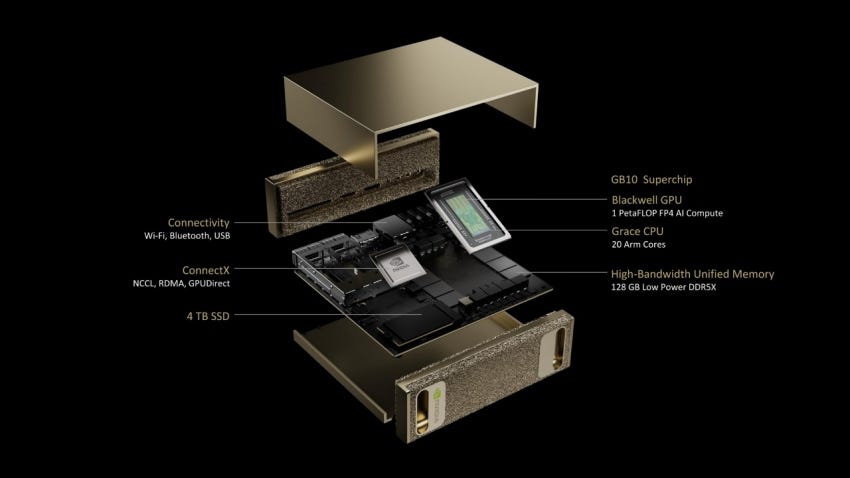🤖 CES 2025: AI Takes Over
From tiny supercomputers to self-driving cars
Welcome to the Premium edition of How They Make Money.
Over 170,000 subscribers turn to us for business and investment insights.
In case you missed it:
CES 2025, the world's biggest tech expo, just wrapped up in Las Vegas.
Every January, CES sets the stage for the year in tech, showcasing everything from mind-bending gadgets to the chips that power our digital lives.
Why should you care? The show offered a glimpse into how AI will transform gaming, computing, and beyond.
Let’s break down the biggest announcements.
Today at a glance:
NVIDIA: AI Supremacy
AMD: Light on GPU Details
Intel: Leadership Transition
Samsung: AI Integration
Sony: Entertainment Focus
LG: Affectionate Intelligence
1. NVIDIA: AI Supremacy
NVIDIA's CEO, Jensen Huang, delivered a keynote address at CES 2025 highlighting the company's continued dominance in AI and expansion into new frontiers like robotics and autonomous vehicles. Below is the full 90-minute keynote for reference, but let’s review it in 90 seconds.
GeForce RTX 50 Series GPUs
The latest generation of NVIDIA graphic cards took center stage:
Blackwell family: Huang unveiled the GeForce RTX 50 series GPUs, built on the latest Blackwell architecture and available in January. These cards represent a leap forward in gaming and AI processing. Models include the flagship RTX 5090 ($1,999) and the RTX 5070 ($549)—notably outperforming the RTX 4090 that launched at $1,599 in 2022.
DLSS 4: The 50 series features the latest version of Deep Learning Super Sampling, which uses a transformer-based architecture to render up to three frames using AI for each traditionally rendered frame. DLSS 4 boosts graphics and improves the gaming experience.
Memory partner: Micron is providing the memory chips for the new GPUs.
If you recall, the gaming segment—where GeForce RTX chips are recorded—has become a small portion of the company’s revenue (9% in the October quarter). The Data Center segment is where AI demand has materialized so far (see visual).
AI Advancements
NVIDIA Nemotron models: Huang introduced a new family of models based on Meta's Llama models, including Llama Nemotron Nano, Super, and Ultra. These models are designed to further improve AI agents, a market Huang believes will be worth trillions of dollars.
Blackwell AI accelerators: Huang confirmed that the Blackwell line of AI accelerators is in full production and being adopted by major cloud providers and PC makers.
Robotics and Autonomous Vehicles
NVIDIA Cosmos: This is the "world's first physical AI model" designed to boost robotics. It's trained on 20 million hours of video and is open-licensed on GitHub.
Omniverse integration: Cosmos works with Omniverse, NVIDIA's digital twin/metaverse platform, to provide a physics-grounded simulation environment for training and refining AI models for robots and autonomous systems.
Toyota partnership: NVIDIA announced a partnership with Toyota to develop the automaker's newest autonomous vehicles.
Market potential: Huang believes the robotics and autonomous technology market represents a $1 trillion incremental market opportunity for NVIDIA.
Automotive growth: Huang expects automotive revenue to increase from $4 billion in FY25 to $5 billion in FY26 (ending January 2026). It includes revenue across multiple segments (notably Data Center and OEM).
Project DIGITS
Huang also introduced Project DIGITS, a personal AI supercomputer.
Desktop AI powerhouse: Starting at $3,000, it features the new GB10 Grace Blackwell Superchip and is designed for AI researchers and data scientists.
Specifications: Each system has 128GB of unified memory and up to 4TB of NVMe storage. Two systems can be linked for even greater processing power.
Accessibility: This product aims to make powerful AI development tools more accessible. It allows users to work on complex AI models without access to large data centers.
Key Takeaway: NVIDIA's CES announcements painted a picture of a company that is not only dominating the AI chip market but also aggressively expanding into new, high-growth areas. The focus on robotics, AVs, and making AI more accessible shows that NVIDIA aims to remain at the heart of this innovation cycle.






